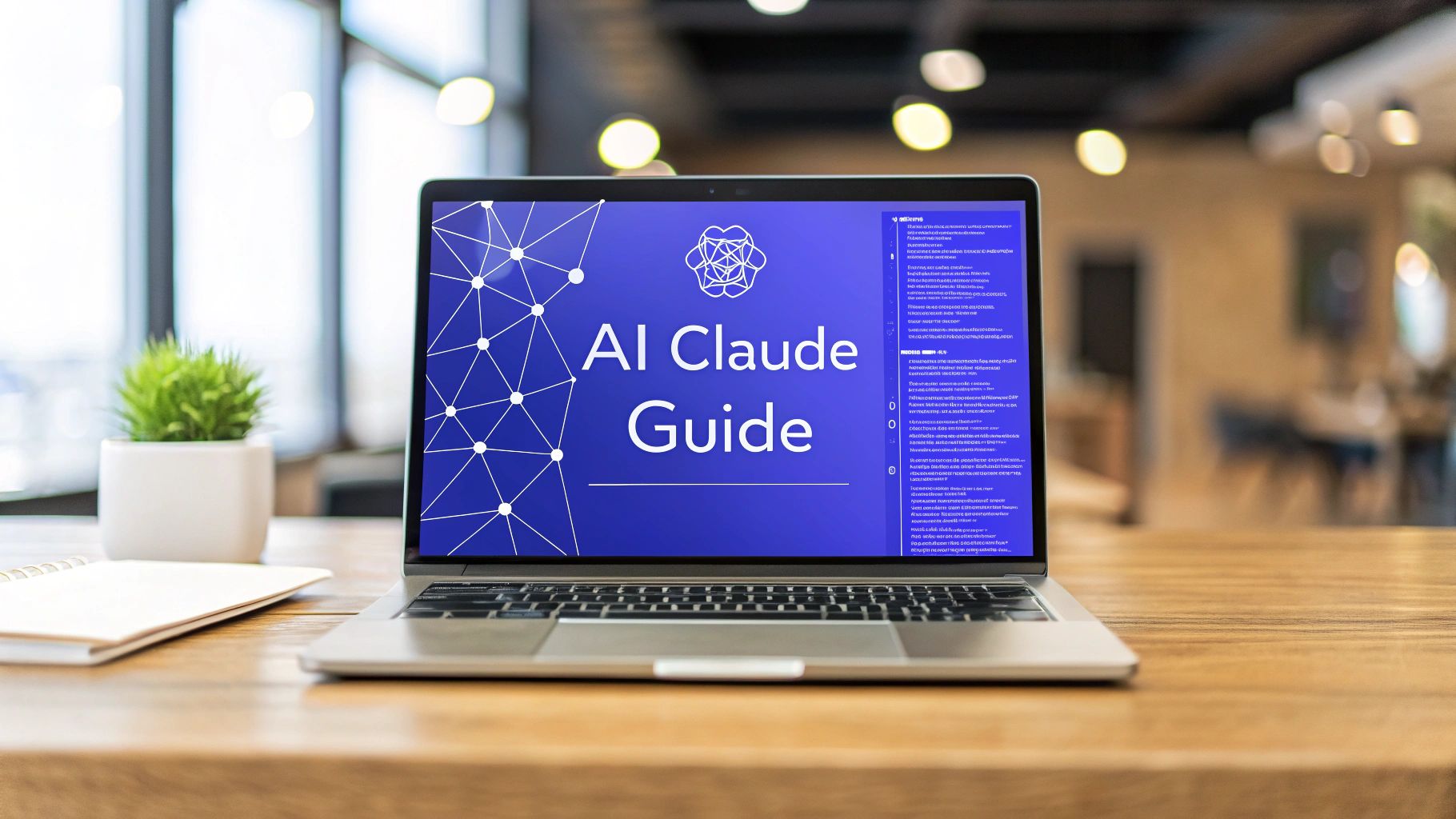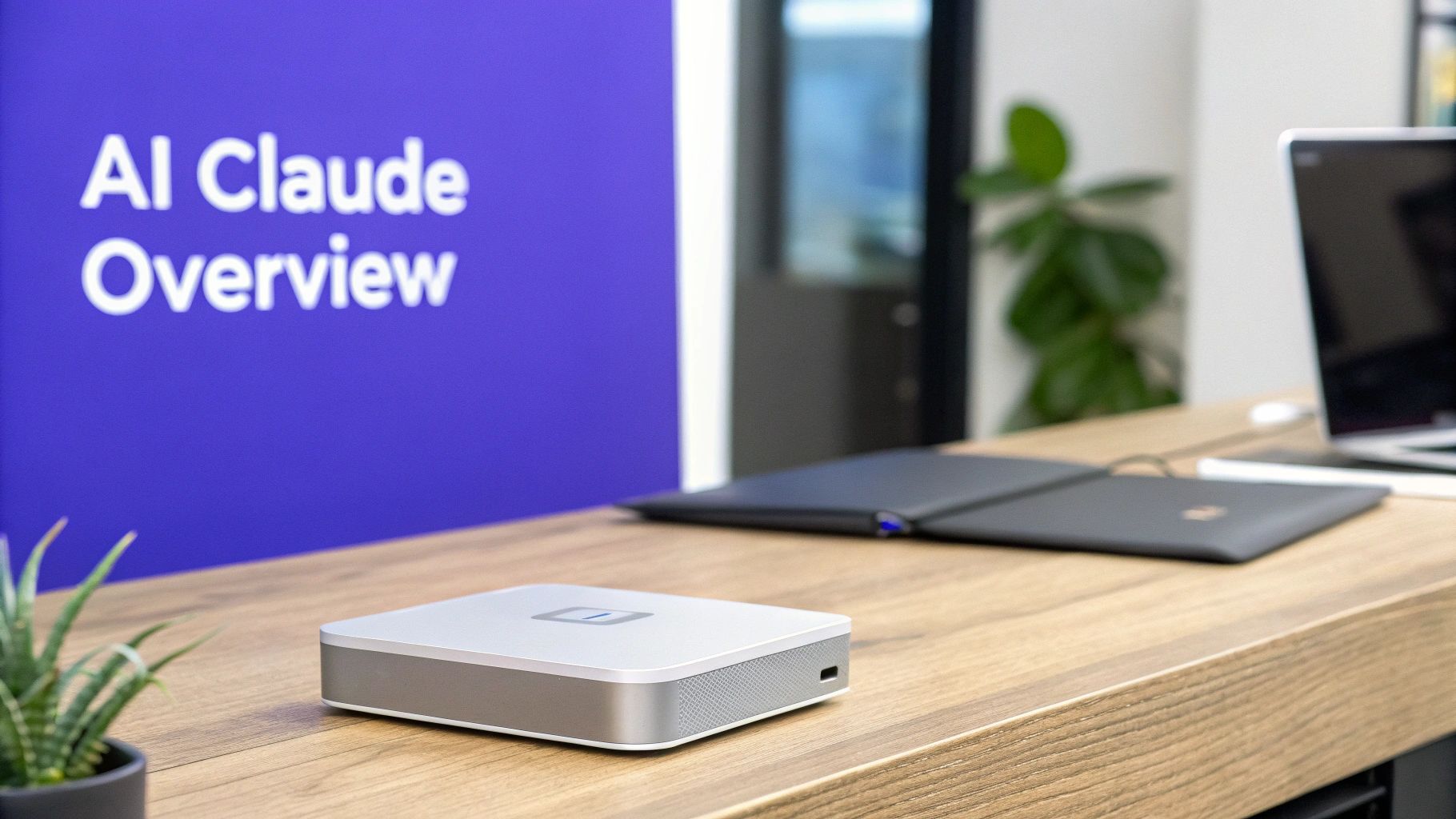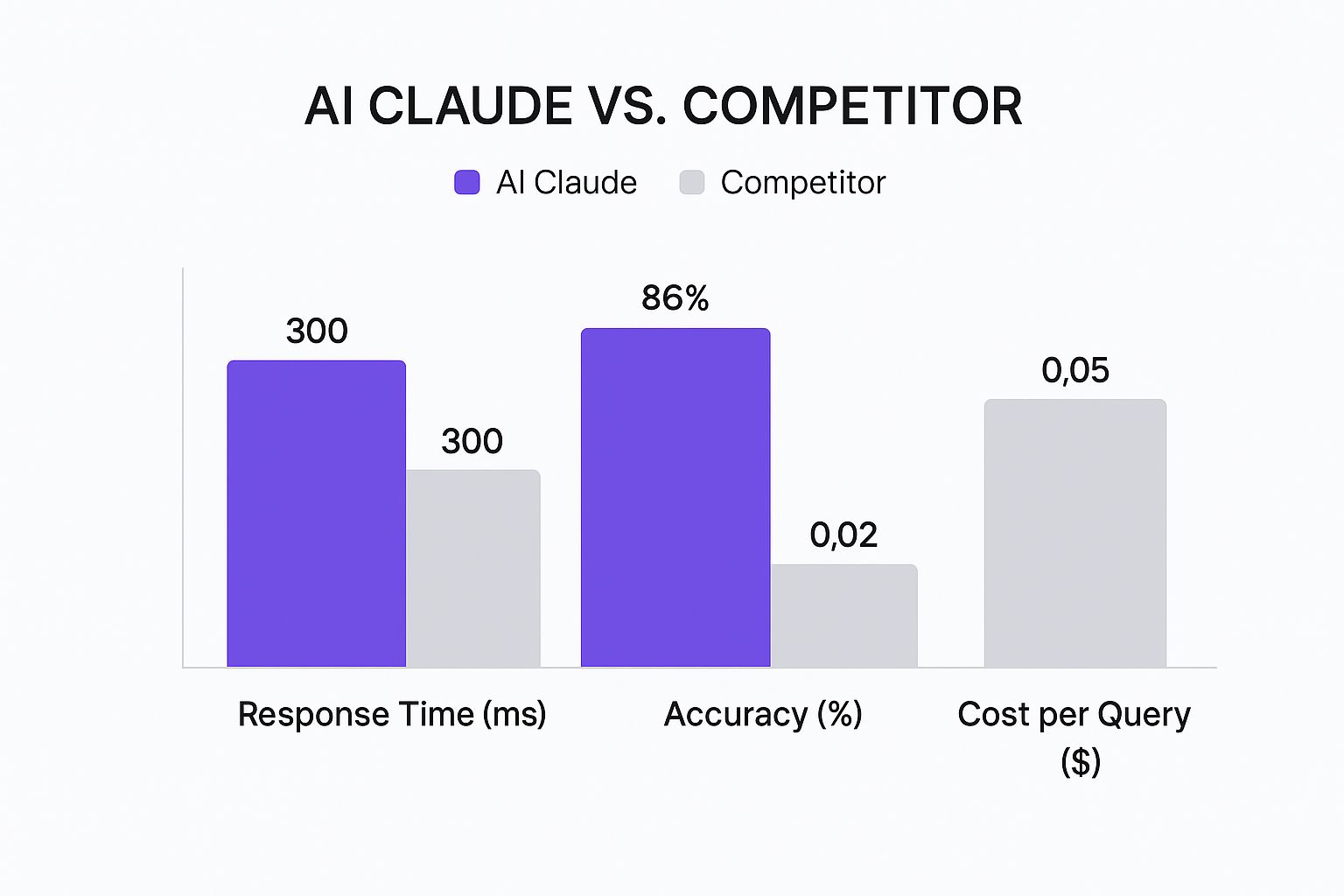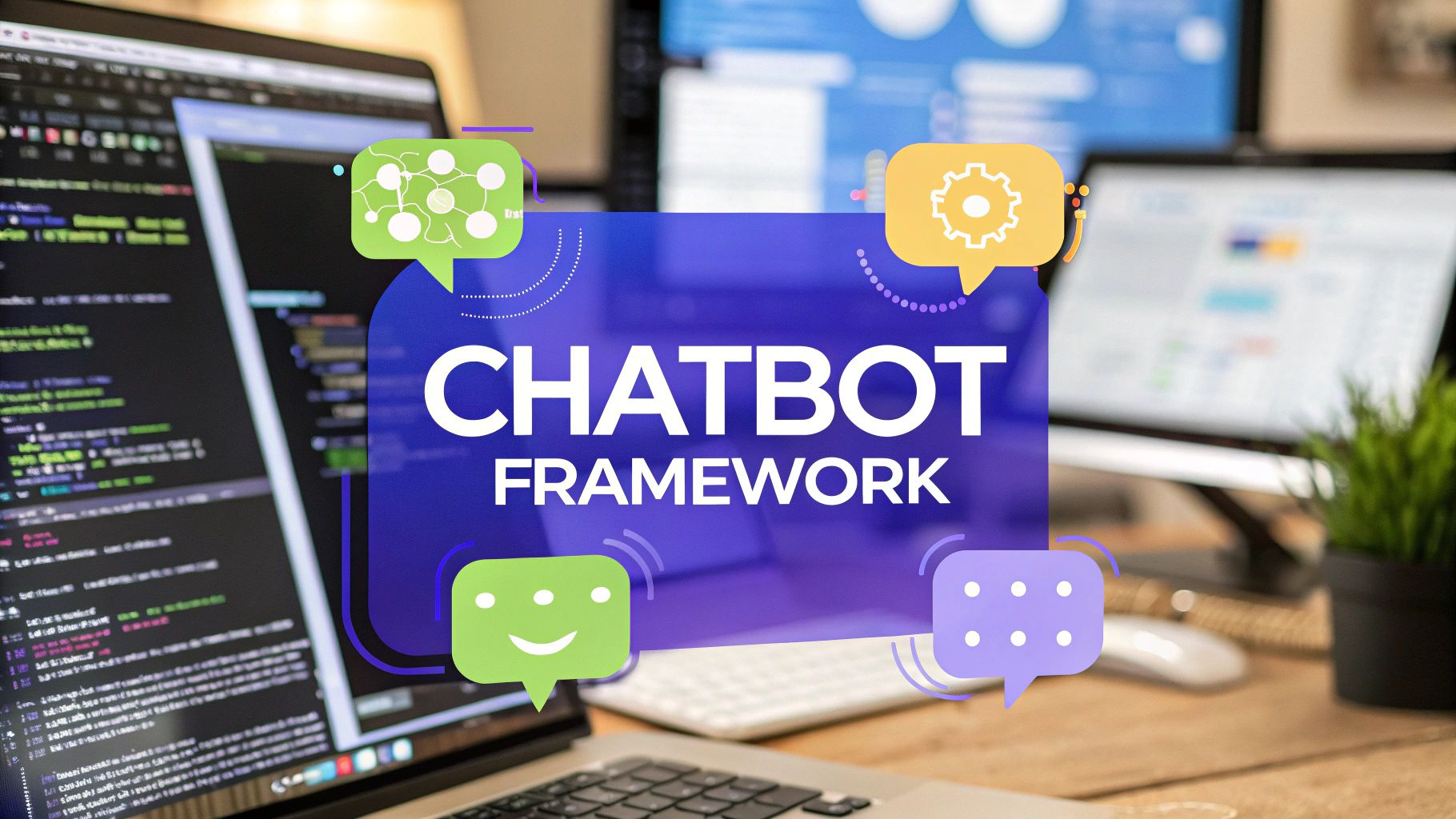A Guide to AI Claude and How It Works
Discover AI Claude, the next-gen AI assistant from Anthropic. This guide explores its unique features, real-world uses, and how it compares to other AI.

Ever feel like you could use a highly skilled research assistant, a creative partner, and a technical expert all rolled into one? That's the idea behind AI Claude, an advanced AI assistant from Anthropic that was built from the ground up to be helpful, harmless, and honest. It represents a more thoughtful approach in the world of artificial intelligence.
What Is AI Claude?

At its core, AI Claude is a large language model created by Anthropic, an AI safety and research company. But it’s not just another chatbot. Think of it as a conversational partner developed with a strong ethical foundation, designed to handle a huge range of tasks while sticking to a strict set of safety rules.
This focus on safety is what really sets Claude apart. Anthropic was founded by former members of OpenAI who wanted to build AI systems that are not only powerful but also fundamentally aligned with human values. This mission is baked into the very DNA of how Claude operates.
A Focus on Constitutional AI
The secret sauce behind Claude's design is a unique method called Constitutional AI. Instead of just relying on human feedback to police its responses, Claude is trained to follow a "constitution"—a set of guiding principles pulled from sources like the UN Declaration of Human Rights. This internal rulebook helps it steer clear of generating harmful, biased, or unethical content.
This approach allows Claude to self-correct its own behavior during training, which leads to much more reliable and predictable outputs. For you, this means interacting with an AI that's intentionally designed to be more thoughtful and less likely to go off the rails with problematic responses.
Key Characteristics and Purpose
So, what does all this mean in practice? AI Claude is built to shine in areas like complex reasoning, thoughtful dialogue, and creative content generation. It's not just about spitting out answers to simple questions; it's about engaging in nuanced conversations and helping with detailed, complex work.
Here’s a quick look at what it's built for:
- A Creative Partner: It can help you draft emails, write scripts, brainstorm ideas, and generate all sorts of creative text.
- A Technical Assistant: Claude can lend a hand with coding, debugging, and making sense of dense technical documents.
- An Analytical Tool: It's great at summarizing long articles, reports, and even books, pulling out the key insights so you don't have to.
Ultimately, AI Claude aims to be a trustworthy and versatile assistant. Its development reflects a deliberate effort to create an AI that isn't just powerful, but also a responsible and safe tool for everyone.
Exploring Claude's Core Capabilities

To really get what makes AI Claude so useful, you have to look under the hood at its core features. These aren't just technical specs on a datasheet; they're the practical strengths that let you solve real-world problems.
Think of it this way: if most AIs give you a small desk to work on, Claude gives you a massive digital workbench. That’s where its power truly begins.
An Expansive Digital Workbench
The feature everyone talks about with AI Claude is its enormous 200,000-token context window. A "token" is just a piece of a word, and 200k tokens equals roughly 150,000 words. This means Claude can read, process, and understand entire books, long research papers, or complex codebases in one go.
Imagine asking an assistant to summarize a novel, but they can only read one page at a time. They'd lose the plot almost immediately. Claude's huge context window lets it "read" the entire book at once, grasping the full narrative, character arcs, and themes from start to finish.
This is a complete game-changer for any task that demands deep contextual understanding.
Advanced Reasoning and Problem-Solving
Beyond just reading a ton of information, Claude is exceptionally good at advanced reasoning. It can connect the dots between scattered pieces of data, spot subtle patterns, and solve tricky problems that go way beyond simple search-and-find.
It’s not just about finding a needle in a haystack; it's about understanding why the needle is even there.
This ability stems directly from its huge context window and its fundamental design, which prioritizes comprehension. For any business, that translates into a serious competitive edge. Our detailed guide on how Claude AI works explores this in much more detail.
These technical advantages are a big reason why AI Claude holds a unique spot in the market. Its focus on safety and a "constitutional AI" framework resonates with enterprise clients, with roughly 60% of Fortune 500 companies now using it for complex tasks like document analysis and strategic reasoning.
To give you a clearer picture, here’s a quick summary of what Claude brings to the table.
AI Claude Core Capabilities at a Glance
This table breaks down Claude's key functionalities, showing what each one does and where it shines the brightest.
Each of these capabilities builds on the others, creating a tool that’s both powerful and incredibly versatile.
So, what can you actually do with all this?
- Draft creative content: Go beyond basic sentences. You can ask Claude to write a detailed story, marketing copy, or even a full script by feeding it extensive background material for a richer, more nuanced output.
- Summarize dense reports: Hand it a 100-page financial report or a dense scientific study. In minutes, you’ll get back a concise, accurate summary with all the key takeaways and data points.
- Debug complex code: Give Claude your entire codebase and ask it to find bugs, suggest performance optimizations, or just explain how different modules interact with each other.
How AI Claude Stacks Up Against Other AI Tools
In a field packed with impressive AI assistants, it's easy to get lost in the noise. When you put AI Claude next to big names like ChatGPT, you'll notice some pretty fundamental differences in how they think and what they're built for. It’s not about finding the single "best" AI, but about matching the right tool to the right job.
The real competition boils down to a few key areas: how much information the model can handle at once (its context window), whether it shines with creative or analytical tasks, and its core philosophy on safety. For example, Claude's "Constitutional AI" framework makes it behave more cautiously and predictably than some of its more freewheeling rivals.
Performance and Core Distinctions
One of AI Claude’s standout features is its absolutely massive context window. It can process and make sense of huge volumes of text in a single go, which is a game-changer for tasks that require a ton of background information. Think summarizing an entire book or poring over a dense legal contract. While other models are certainly powerful, they can sometimes lose the thread when dealing with that much input.
This image shows how AI Claude's performance metrics compare to a typical competitor, breaking down data on response time, accuracy, and cost.

As you can see, there's often a trade-off. Claude tends to lean toward higher accuracy, which is invaluable for analytical work and business applications where getting it right matters most.
So, how do these differences actually play out in the real world? When you're picking an AI, think about what you're trying to accomplish:
- For Creative Brainstorming: Some models deliver more spontaneous, stylistically diverse ideas, which can be fantastic for ideation. Claude, on the other hand, is excellent at producing well-structured, coherent, and thoughtful content, especially for long-form writing.
- For Deep Analysis: This is where Claude’s huge context window and reasoning abilities truly shine. It can digest and synthesize complex documents with impressive accuracy.
- For Safety-First Applications: If you need a tool that's reliable and has a low risk of generating inappropriate or problematic content, Claude’s safety-centric design gives it a clear edge.
Ultimately, the best choice really does depend on the job at hand. Are you firing off a quick social media post or drafting a detailed technical report? Answering that question will point you straight to the right AI partner for your workflow.
Putting AI Claude to Work in the Real World
Theory is great, but results are what matter. Beyond the technical specs, you really start to see what AI Claude can do when you watch people use it to solve actual problems and make their daily work easier.
These real-world examples show just how flexible it is. For instance, a researcher can drop hundreds of pages of dense scientific papers into Claude and get a sharp, accurate summary back in minutes. This is a game-changer for tasks like literature reviews that used to eat up days or even weeks.
Boosting Professional Productivity
The impact is felt across all sorts of industries. A legal team can feed AI Claude a complex contract and have it instantly flag key clauses, potential risks, and important obligations. This saves an incredible amount of time and cuts down on the human error that can creep in when you’re staring at long documents.
Or think about a marketing team. They can use it as a creative partner. Give it a brief and a target audience, and in one session, they can brainstorm dozens of unique campaign angles, ad copy variations, and fresh content ideas.
This isn't about replacing human skill—it's about augmenting it. Claude acts as a powerful assistant that handles the heavy lifting, freeing up professionals to focus on strategy, creativity, and the big-picture thinking that really moves the needle.
Solving Technical and Customer-Facing Challenges
For developers, Claude is like having a tireless debugging partner on call. A programmer can upload an entire codebase, describe a stubborn bug, and get targeted suggestions for how to fix it. It’s particularly good at understanding complex application logic, making it a powerful tool for optimizing and maintaining code.
Its skills also stretch to customer-facing roles. When you train it on your own company’s data, it can power some seriously smart support systems. You can learn more about how to set up an AI chatbot for customer service in our detailed guide, which walks through creating assistants that give genuinely helpful answers.
All of these applications show how AI Claude goes from being an abstract idea to a tool that delivers real, measurable results.
Understanding Claude's Rapid Market Growth

The buzz around AI Claude isn't just about cool tech—it's backed by real-world adoption and serious industry confidence. The model has quickly become a major player in the AI space, carving out a significant audience thanks to its unique focus on safety and powerful analytical skills.
Its growth has been especially impressive in key global markets and with younger users. Out of nearly one billion people using AI chatbots worldwide, Claude has captured a sizable slice. It now has 3.2 million monthly users in the United States and 2.1 million in India alone. What’s more, about 77% of its user base is under 35. You can dig into more of these numbers and see the data behind Claude's growth on thunderbit.com.
Major Investments Signal Industry Trust
This kind of explosive growth doesn't go unnoticed, especially by the biggest names in tech. The massive financial backing AI Claude has received is a strong vote of confidence in its long-term potential and its distinct, safety-first approach to AI.
You can tell a lot about a technology's future by who is willing to bet on it. When tech giants invest billions, it’s a clear sign they believe Anthropic's vision is a critical piece of the AI puzzle.
This isn't just talk. Look at the funding rounds:
- A massive investment of around $4 billion from Amazon.
- Another huge commitment of about $2 billion from Google.
These aren't just cash infusions; they're strategic partnerships. This level of backing gives Anthropic the fuel it needs to scale up, refine its models, and stay competitive. It’s exactly what a company needs to build a reliable and secure chatbot for enterprise solutions. For all of us, it means a more stable and consistently improving platform, cementing AI Claude's role as a major force shaping where artificial intelligence goes next.
When you look at what’s next for AI Claude, it all comes back to a unique idea called Constitutional AI. This isn't just another feature on a list; it’s the philosophy at the heart of how Anthropic is building safer, more reliable AI that actually aligns with human values.
So, what is it, really? Think of it like this: most AI learns from massive amounts of data. But Claude is also trained to follow a specific set of principles—a "constitution." This rulebook is inspired by core ideas from texts like the UN's Universal Declaration of Human Rights, plus other principles centered on fairness and safety. Instead of just relying on people to flag bad behavior after the fact, Claude learns to supervise itself based on these foundational rules.
This approach is central to where Claude is headed. It ensures that as the AI gets more powerful, it also gets inherently more helpful and harmless.
The whole point is to build a more predictable and trustworthy AI partner. The goal is an assistant that can self-correct, dramatically reducing the chances of it generating biased, unethical, or dangerous responses without a human constantly looking over its shoulder.
The future for AI Claude is all about refining this constitution, sharpening its advanced reasoning skills, and systematically rooting out biases. It’s a thoughtful approach that ensures the technology evolves not just in raw power, but in its fundamental alignment with the people it’s built to serve. That’s how you get a tool that’s truly dependable for everyone.
Common Questions About Claude
As you start exploring what Claude can do, a few practical questions always pop up. Getting clear on the basics—like how to access it, how your data is handled, and what it can (and can’t) do—will help you use it with confidence.
Is There a Free Version of Claude?
Yes, there is. Anthropic makes Claude available through a few different tiers, so you can start with a free version that’s surprisingly generous for everyday tasks like summarizing articles or drafting emails.
For anyone with more demanding needs, there are paid plans like Claude Pro and the Claude API. These tiers are built for professionals and businesses with heavier workloads, offering much higher usage limits, priority access during busy periods, and the keys to their most powerful models.
How Does Claude Handle My Data?
This is a big one, and data privacy is something Anthropic has built into Claude’s DNA. They have a strict policy against training their models on any data you submit unless you give them explicit permission. Your prompts and conversations are your own—they aren’t used to teach the AI unless you specifically opt into a data-sharing program.
This commitment is a major reason why businesses feel comfortable using Claude for confidential work. You can work with sensitive information knowing your data stays private.
Can Claude Access the Web?
Right now, Claude does not have live access to the internet. It can’t browse the web for real-time information like today’s news or stock prices.
Its knowledge comes from the massive, stable dataset it was trained on, which has a specific cut-off date. This is a deliberate design choice that aligns with Anthropic’s safety-first approach, ensuring its answers are based on a vetted body of information rather than the wild west of the live web.
Ready to build an AI assistant that understands your business? With Chatiant, you can create a custom chatbot trained on your own data. Start building your AI agent today at chatiant.com.


